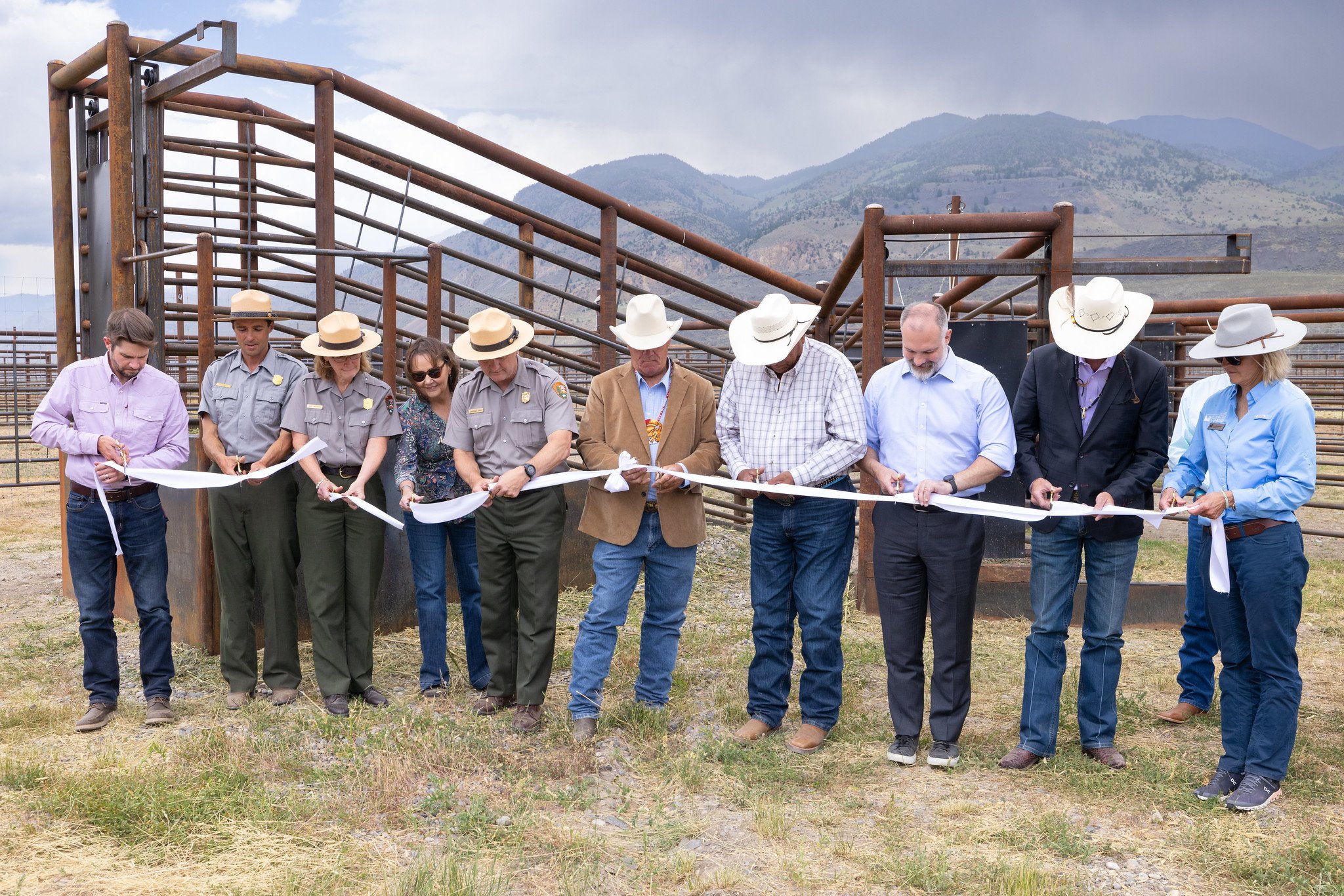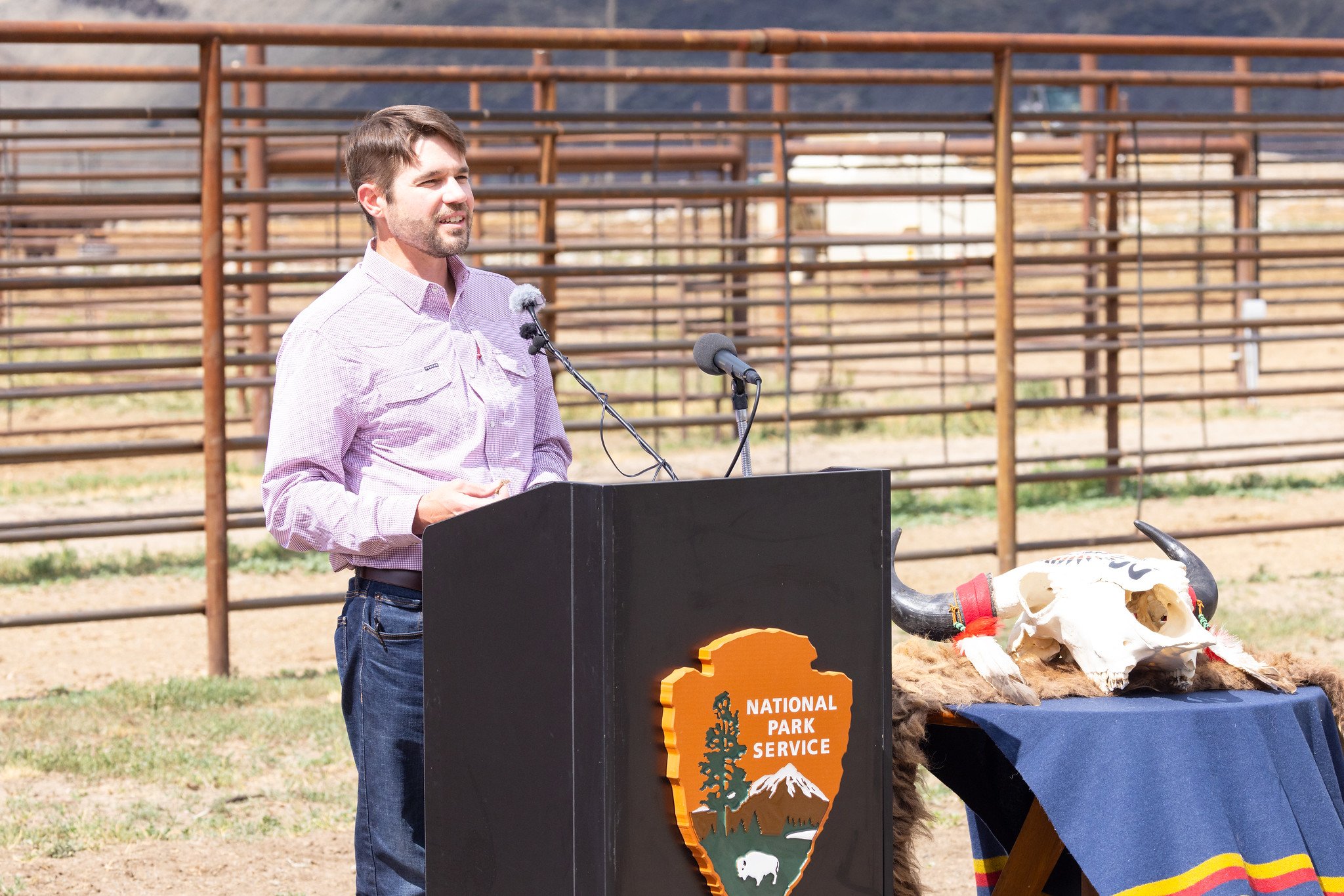GYC and partners celebrate Bison Conservation Transfer Program and quarantine facility expansion
It is hard to overstate the ecological and cultural significance of Yellowstone’s iconic wild bison herd. Despite this, their conservation and management is arguably one of the most complex and hotly debated wildlife issues in the region, perhaps the country. This past winter was no exception, with an unprecedented, highly visible modern-day Tribal harvest. And with ongoing draconian state politics threatening to undo years of progress in Montana, it’s easy to lose sight of not only how far we’ve come, but also where we are headed in the future.
In the conservation community, we rarely take the time to stop, take stock, and celebrate our progress. The long and arduous work of restoring our nation’s last wild bison herd is no exception. However last week, we finally did just that. On July 13, 2023, the Greater Yellowstone Coalition joined Yellowstone National Park, Yellowstone Forever, Tribal Nations and other key federal and NGO partners to celebrate the completed expansion of the Yellowstone Bison Conservation Transfer Program (BCTP) and quarantine facility.
The ribbon cutting at the Bison Conservation Transfer Facility Expansion event. Left to Right: Scott Christensen, executive director, Greater Yellowstone Coalition; Chris Geremia, senior bison biologist, Yellowstone National Park; Kate Hammond, regional director, National Park Service; Majel Russell, Crow Tribe of Indians; Cam Sholly, superintendent, Yellowstone National Park; Robbie Magnan, game and fish director for the Fort Peck Assiniboine and Sioux Tribes; Ervin Carlson, president, InterTribal Buffalo Council, Blackfeet Nation; Tommy Budreau, deputy secretary, Department of Interior; Troy Heinert, executive director, InterTribal Buffalo Council; Lisa Diekmann, president and chief executive officer, Yellowstone Forever. (NPS / Jacob W. Frank)
This monumental program was first implemented in 2018 after years of work on the part of Yellowstone National Park, the Assiniboine and Sioux Tribes of the Fort Peck Indian Reservation, the InterTribal Buffalo Council, conservation groups, and state and federal agencies as a way to divert disease-free Yellowstone bison from slaughter and rehome them to Tribal and ancestral lands across North America. Because domestic cattle introduced the livestock disease brucellosis into Yellowstone elk and bison populations in the 1930s, Yellowstone bison cannot easily be rehomed like other bison herds without first ensuring they are disease-free. Through the BCTP, the Park Service passively captures bison as they leave the park and moves them through a series of testing and holding facilities designed to ensure they are, and will remain, disease-free. The bison are then transferred to the Fort Peck Indian Reservation in northern Montana to finish their final year of quarantine before the InterTribal Buffalo Council distributes them to Tribal lands across North America. In their new homes, these bison strengthen the genetics of Tribally-managed herds and restore the connection between wild bison and the people and communities who have depended on them for millennia.
This program started out small. Initially, the facility was only able to handle less than 80 bison at a time. Meanwhile, hundreds of other disease-free, genetically incomparable wild Yellowstone bison were sent to slaughter each year. Then in 2021, GYC partnered with Yellowstone National Park and Yellowstone Forever to collectively raise $1 million to nearly triple the size of Yellowstone’s quarantine facility so that more bison could be diverted from slaughter and rehomed to Tribal lands. The expansion was completed last summer and as a result we saw the largest bison transfer to date this past January when 112 Yellowstone bison were sent to the Fort Peck Indian Reservation. In the months following, Yellowstone National Park entered a record number of bison (282 total) into the program. Since the program began in 2018, nearly 300 Yellowstone bison have been diverted from slaughter and rehomed to the lands of 23 Tribal Nations across 13 states.
But this is just the beginning. Through work to increase the efficiency of this program and shorten the duration of time it takes for bison to complete this process, as well as developing one or more additional quarantine facilities, we hope to continue growing this program. We want to see an end to the slaughter of Yellowstone’s iconic wild bison population so that these animals can lead the way in restoring landscapes of the West and contribute to the return of bison as the center of the cultural, spiritual, economic, and nutritional sovereignty of Tribal Nations.
Last week we came together and celebrated how far we’ve come, while acknowledging how far we still have to go. Together, we are rewriting the narrative around Yellowstone bison management, from one of controversy and slaughter to one of hope and restoration. Leroy Stewart, director of the buffalo program at Crow Nation, kicked off the celebration with an opening prayer of gratitude, hope, and healing around what the return of the buffalo represents to Native people. Ervin Carlson, president of the InterTribal Buffalo Council, representing more than 80 Tribes in the pursuit of restoring buffalo to Indian Country, spoke of the absolute necessity of this program and how buffalo are central to Native American life, saying “…they’re our relatives. They’re one and the same with us.”
Yellowstone Superintendent Cam Sholly spoke of his determination to move away from sending Yellowstone bison to slaughter while prioritizing the federal government’s trust responsibility to support Tribes with the ecological and cultural restoration of the species. Many others provided moving remarks, including GYC’s Executive Director Scott Christensen. He was quoted saying, “…This was only possible and will only continue to be possible through strong partnerships. The work requires a diversity of people, agencies, institutions, Tribal Nations, and organizations coming together to unite for a common goal and shared vision of a better, more resilient, whole future that includes buffalo once again roaming Tribal and ancestral lands across the North American landscape.”
GYC Executive Director Scott Christensen speaks at the Bison Conservation Transfer Facility Expansion event. (Photo NPS/Jacob W. Frank)
As we celebrated our recent accomplishments, GYC also committed to continue to grow this program with all the support and momentum from the federal administration, Tribal Nations, and nonprofit partners.
Soon there will be an opportunity to weigh in on Yellowstone National Park’s new draft Bison Management Plan. It will be important for all of us to support a new plan that continues to restore our nation’s most culturally and ecologically significant wild bison herd to lands outside the park. In addition, it will be important that this new plan is rooted in science and moves away entirely from slaughter while prioritizing the use and continued expansion of the Bison Conservation Transfer Program. Together, we can make history and write a better future for Yellowstone bison and Tribal Nations in Greater Yellowstone and beyond.
—Shana Drimal, Senior Wildlife Conservation Associate



